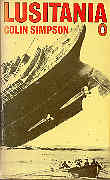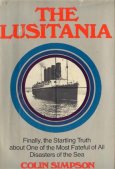| CLASSIC DIVE BOOKS
The loss of the "Lusitania". |
HOMEPAGE |
|
Please note: The books are listed for interest only, and not offered for sale. |
| On 7 May 1915 at2.28 p.m.
the great Cunarder Lusitania sank off the Old Head of Kinsale, Ireland,
eighteen minutes after being torpedoed by the German submarineU-20; 1201
men, women and children died - many of them United States citizens. The
inquest at Kinsale brought an indictment of 'wilful and wholesale murder'
against the Kaiser. The official versions of the sinking said that this
innocent passenger liner had been wantonly sunk by two or more German torpedoes
in contravention of international agreements. The disaster was among the
chief of many factors which brought America onto the course of war.
This is not meant to be a definitive list of books on the Lusitania. |
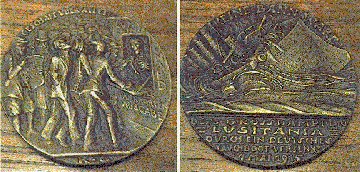 |
'With the loss of the Lusitania
to a German submarine on 7 Mat=y 1915, German metalworker Karl Goetz minted
a commemorating medal for distribution within Germany. This was not so
unusual; during the war some six hundred commemorative medals of various
kinds were struck by private German mints. What brought Goetz's metallic
lampoon to rub salt into the British wounds in dispute was the lack of
respect that was shown for the dead. The medal depicted passengers lined
up like cattle to buy tickets from Death personified as a skeleton, with
the blessing of Cunard, and a ship bristling with guns and ammunition.
Interestingly, the first lot minted showed the date of 5 Mai - two days
before the loss of the ship.This has given rise to speculation that the
medal was struck in advance, in bold ainticipation of the accomplishment
of so difficult a task, which accordingly must have been premeditated -
more twisted evidence for conspiracy theorists. The true explanation
was a typographical error. It appears that not all of the german medal's
had the erroneous date of 5 Mai.
The medal was not widely circulated and went barely noticed in Germany, but England, in a clever mood, counterfeited thousands and distributed them to an aroused civilian populace to further fan the flames of fevor. Thus the real import of Goetz's medal was that it kept the tragedy of the Lusitania alive in the minds of the people. It is not difficult to asscertain whether a medal is German or British. The German spelling for the month is used on the German medal - that of Mai; the British of course write May. Also, a skilled observer will notice the differencve in the quality of the medals - the German medal is finely minted on quality metail which appears to have more copper in it, giving a bronze glow. The British mass produced medal is on lesser quality metal. I understand also that the German medal had a mint mark on its edge. As a matter of financial
interest, the German medal tends to go for around US$500 on eBay - but
this varies of course. (One went for US$475 in 2002). The British medal
can go for several hundred dollars but generally no more. One eBay sale
of the British medal came with ‘an original box', with an image of the
great four-funneled ship, and text inside the lid as:
|
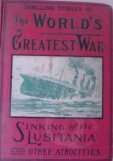 |
THE
WORLD'S GREATEST WAR STORIES.
SINKING OF THE LUSITANIA AND OTHER ATTROCITIES. Hardcover, illustrated boards, 482 pages. "Illustrated with nearly 100 actual photographs from the scenes of strife." No further details. |
||
| THE
LAST VOYAGE OF THE LUSITANIA
A.A.Hoeling, and Mary Hoeling. Published by The Quality Book Club, London, in arrangement with Longmans Green & Co, Ltd. No date, but epilogue infers 1956. Hardcover, probably a dust jacket (none on my copy), 184 pages, bibliography (further reading), twenty-two excellent, historic photographs. There have been quite a few book written on the tragic loss of this liner off Ireland in 1915. Certainly this is one of the earliest. [ps] |
|||
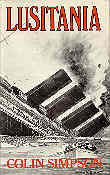
. |
LUSITANIA
Colin Simpson. Longman Group Limited, London, 1972 ISBN 0 582 12707 6 From the fly: Colin Simpson was intrigued by the mystery which still surrounded much of the Lusitania story and began his enquiry. What he discovered - about the Lusitania's stated purpose in the event of war, about the real nature of her cargo andequipment,abqut :Sritish secret service operations in the U,S., about the use and non-use of evidence at the subsequent British and American official enquiries -led to the writing of this I explosive book. It tells in fascinating and circumstantial detail the story of the Lusitania's construction, her last voyage, sinking, and the aftermath viewed against a background of British naval policy, U.S. diplomacy, and backstage governmental activities. For more than 50 years the sinking of the Lusitania has been proclaimed as an act of naked and brutal aggression against an innocent ship carrying citizens of a neutal country; this book shows beyond doubt that the true facts were deliberately concealed and shockingly different. Very well researched and written. Hardcover, dustjacket, 295 pages, mono plates. Paperback also released. [ps]
|
||
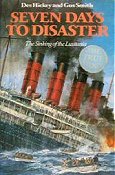 |
SEVEN DAYS TO DISASTER
The Sinking of the Lusitania. Des Hickey and Gus Smith. Published by Collins, London UK, 1981 Hardcover, 5 3/4 by 8 3/4", dust jacket, a few b&w photos and illustrations, 336 pages. Hickey and Smith have retraced the Lusitania's last voyage meticulously. They have collected first-hand accounts from survivors, uncovered new facts about a mutiny on board the U-boat, about a nest of German saboteurs in New York and about the violent world of the 'dirty gang' below decks. Original sticker on the front reads "The True Story". Information acknowledgement: eBay. |
||
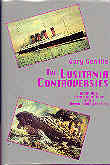
. 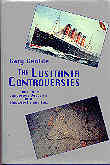 |
THE
LUSITANIA CONTROVERSIES. Two volumes.
Gary Gentile. I was attracted to read these books because of a fascination with the Lusitania, which, as you probably know, was torpedoed off the coast of Ireland in 1915. But, as the cliche says, dont judge a book by its cover. Although the two volumes contain an interesting account of the loss of the Cunard liner, and an even more fascinating description of diving the ship, these books are an authobiography of one of most experienced and influential deep wreck divers in the world. I was initially disappointed at the sparcity of historic Lusitania facts, but Gentile's excellent writing drew me in to a world of incredible deep diving, pioneering new techniques, and virgin wrecks at over 300 feet. Of particular fascination, and one in which we can at times relate, is the petty-mindedness of government officials and the sheer bitchines of dive boat skippers and fellow divers. There seems to be a nasty rivalry betwen fellow deep-wreck divers in seeking the rewards of relics to be raised and taken into personal posession. Well, been there, done that! But Gentile pulls no punches in his condemnation of divers who lack the skills and the mental attitude to be ‘real wreck divers'. Here we have entwined superb diving with tragic episodes on the Andrea Doria, the Empress of Ireland, the Lusitania, and many other deep shipwrecks and submarines not so well known. The death toll on some of these ships is staggering for a recreational activity - thirteen at least so far on the Andrea Doria. Gentile's writing absorbs you into the scenario like a good work of fiction - which this is most assuredly not. And to make matters even more remarkable I that Gentile was shot through the chest whilst on duty in Vietnam, taking many years to recover, but not fully. This is a book(s) for the serious wreck, deep and technical diver, or, like myself, someone fascinated by the pioneering exploits of these adventurers. And all the action has taken place within the last few decades. A remarkable read. Two volumes, hardcover, dust jacket, 312, 392 pages, mono and colour plates. $90.00 (two volume set). Currently in print. Available from Oceans Enterprises. [ps] |
||
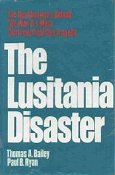 |
THE
LUSITANIA DISASTER
An Episode in Modern Warfare and Diplomacy. Thomas A Bailey and Paul B Ryan. Published by The Free Press in 1975. Hardcover,383 pages with index, bibliography, extensive footnotes, dozens of old photos, cartoons, drawings and maps. This is the detailed story of the British passenger ship Lusitania which was sunk by the Germans on May 7, 1915. The Lusitania was the pride of the Cunard fleet, a ship of immense proportions and capable of great speed. Carrying 1,959 passengers, she left New York on May 1, 1915, bound for Liverpool. They were dangerous times and these were dangerous waters, where U-Boats were active. At 2:10 pm, U-20, commanded by 30-year-old Walter Schweiger, fired a single torpedo. There was an explosion on board the Lusitania, immediately followed by a second louder one. The ship listed quickly and 18 minutes later she sank. 1,200 people died. It was one of the worst great disasters of all time. Information acknowledgement: from eBay. |
||
 |
TRAGEDY
OF THE LUSITANIA.
Memorial Edition. 1915. A vivid and graphic description of the torpedoing of the Lusitania, the "Queen of the seats", and the heartrending account of the panic-stricken men, women and childdren, who were separated from their loved ones to face death, and were hurled into eternity without warning. Embracing authentic stories by the survivors and eyewitnesses of the disaster. Including Atrocities on land an dsea, in teh air, etc. Illustrated. with photographic picu\tures and pencil drawings. |
||
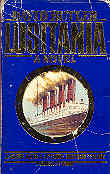 |
LUSITANIA
- A NOVEL
David Butler. First published in Great Britain in 1981 by Macdonald & Co. (Publsihers) Ltd, London and Sydney. Futura paperback edition 1982. ISBN 0 7088 2135 9 A whopping 864 pages. From the blurb: In this majestic novel David Butler portrays the Lusitania's last voyage from New York and her casastrophic encounter with the U-20 twelve miles off the coast of Ireland. It is not only th story of the two ships but also of the men and women who lived and died in this epic of heroism and suffering. The blurb is enough to pout you off reading the book, which I have not done. From an historic point of view, one could asume that the book would be of little factual value. [ps] |
||
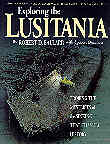 |
EXPLORING
THE LUSITANIA
Probing the Mysteries of the Sinking That Changed History. Robert Ballard with Spencer Dunmore. Paintings by Ken Marschall. Madison Publishing Inc., Canada. First published Great Britain 1995 by Weidenfeld and Nicolson. Hardcover, dustjacket, A4 sizem 224 pages, index, bibliography. A surperb book, and one which will surely be a collectors item in years to come, although it is likely to be reprinted many times. Extensively illustrated with historic photographs, and in many instances, with comparable underwater photographs taken of how the ship now lies, by the Ballard crew which visited the site in 1993. Marschall's painting are incredible. The historic content of the book is much the same as from previous authors such as Hoeling and Simpson, so dont expect to find the perennial answer to th controvery of whether she was carrying contrabnd or not. She was, so thats that. But it was not an explosion of the ammunition that put her on the bottom so quickly. The strength of this book is the hisroric photographs and juxtaposed omages of how she was then, and how she lies now. [ps] |
